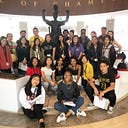Gentrification under the USC population
The presence of the USC village skews perspective on gentrification and a direct correlation with culture.
By Meysi Ramon
The USC Village, a small center equipped with housing, shops and dining halls, was recently renovated in 2016. Prior to this new installment, the USC Village was significantly smaller. Community members familiar with the 1.25 million facility recognize the Trader Joes, Target, Starbucks and FedEx in this small center. Although the facility does prove to raise it’s essentiality for USC students, community members recognize the lingering effects of gentrification on culture, business and lifestyle.
Roots of gentrification stem from the process of removing deteriorated urban areas with eye-appealing infrastructures. The term gentrification, however, has since developed into a larger spectrum of what it means to have a community gentrified.
According to community members, students and faculty of USC, gentrification can range from rebuilding a community for the better, to the displacement of low-income community members.
In early years, the old USC Village was home to smaller franchises. The renovations of the campus have been both developed advancements and have allowed a different sense of culture within it. Hugo Ramirez, 45, is a local fruit business owner stationed in the intersection between USC and the village. Ramirez, a micro-entrepreneur of fruit in the surrounding area, has experienced the effects of gentrification. He said his business is at risk due to gentrification of the university’s expansion.
When asked about the worry of competitiveness with other shops such as Trader Joes’ and Target’s pre-packaged fruit, Hugo stated that “Those other shops may be easy, but at least I know that my own fruit is fresh and prepared daily on the spot,” Ramirez said, talking about his competition at the Village: Trader Joe’s and Target, “The university needs to allow more business owners like me to sell around here.”
Mayra Blas Roja, 20, will be in her third year at USC this fall. Roja has experienced both the effects of gentrification on a personal level and the impact it created on the surrounding community.
“Many people have also been displaced by USC for more [campus] housing. This affects me as I often feel so guilty for consuming at the Village,” Roja wrote in an email interview.
She explained that “gentrification is often done by people from outside the area with intention to improve or revitalize the place. It is happening in places like Downtown LA and the USC Village.”
However, Samir Ghosh, program specialist at USC, stated “entitled to feel as if my culture is mis-represented. LA is a big space, corporations are doing their job and finding strategies to become profitable. If I could, I’d probably do the same.”
Nonetheless, gentrification is still a definition with many complexities. It’s difficult to pertain to simply one association , when there are many factors that come into play to understand the systemic roots of gentrification.
The USC Village is just one of many installments that were created to cultivate a better community. However, gentrification has been seen as a larger prominent conflict with more people expressing their concerns. With more potential university improvements and expansions in the future, South Central will continue to speak out on their opinions on this issue.

